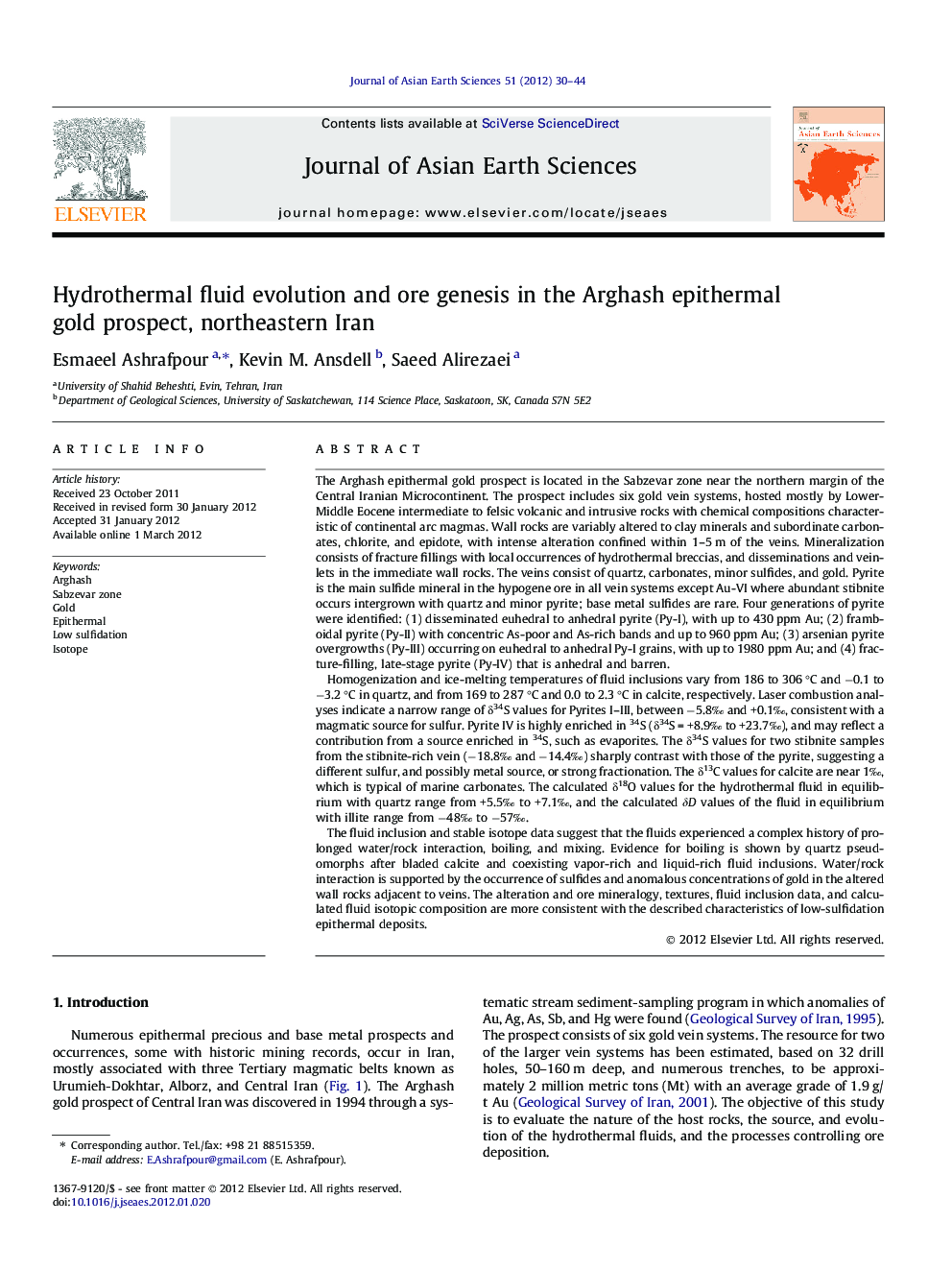| کد مقاله | کد نشریه | سال انتشار | مقاله انگلیسی | نسخه تمام متن |
|---|---|---|---|---|
| 4731456 | 1640413 | 2012 | 15 صفحه PDF | دانلود رایگان |

The Arghash epithermal gold prospect is located in the Sabzevar zone near the northern margin of the Central Iranian Microcontinent. The prospect includes six gold vein systems, hosted mostly by Lower-Middle Eocene intermediate to felsic volcanic and intrusive rocks with chemical compositions characteristic of continental arc magmas. Wall rocks are variably altered to clay minerals and subordinate carbonates, chlorite, and epidote, with intense alteration confined within 1–5 m of the veins. Mineralization consists of fracture fillings with local occurrences of hydrothermal breccias, and disseminations and veinlets in the immediate wall rocks. The veins consist of quartz, carbonates, minor sulfides, and gold. Pyrite is the main sulfide mineral in the hypogene ore in all vein systems except Au-VI where abundant stibnite occurs intergrown with quartz and minor pyrite; base metal sulfides are rare. Four generations of pyrite were identified: (1) disseminated euhedral to anhedral pyrite (Py-I), with up to 430 ppm Au; (2) framboidal pyrite (Py-II) with concentric As-poor and As-rich bands and up to 960 ppm Au; (3) arsenian pyrite overgrowths (Py-III) occurring on euhedral to anhedral Py-I grains, with up to 1980 ppm Au; and (4) fracture-filling, late-stage pyrite (Py-IV) that is anhedral and barren.Homogenization and ice-melting temperatures of fluid inclusions vary from 186 to 306 °C and −0.1 to −3.2 °C in quartz, and from 169 to 287 °C and 0.0 to 2.3 °C in calcite, respectively. Laser combustion analyses indicate a narrow range of δ34S values for Pyrites I–III, between −5.8‰ and +0.1‰, consistent with a magmatic source for sulfur. Pyrite IV is highly enriched in 34S (δ34S = +8.9‰ to +23.7‰), and may reflect a contribution from a source enriched in 34S, such as evaporites. The δ34S values for two stibnite samples from the stibnite-rich vein (−18.8‰ and −14.4‰) sharply contrast with those of the pyrite, suggesting a different sulfur, and possibly metal source, or strong fractionation. The δ13C values for calcite are near 1‰, which is typical of marine carbonates. The calculated δ18O values for the hydrothermal fluid in equilibrium with quartz range from +5.5‰ to +7.1‰, and the calculated δD values of the fluid in equilibrium with illite range from −48‰ to −57‰.The fluid inclusion and stable isotope data suggest that the fluids experienced a complex history of prolonged water/rock interaction, boiling, and mixing. Evidence for boiling is shown by quartz pseudomorphs after bladed calcite and coexisting vapor-rich and liquid-rich fluid inclusions. Water/rock interaction is supported by the occurrence of sulfides and anomalous concentrations of gold in the altered wall rocks adjacent to veins. The alteration and ore mineralogy, textures, fluid inclusion data, and calculated fluid isotopic composition are more consistent with the described characteristics of low-sulfidation epithermal deposits.
► Trace element compositions of igneous rocks in Arghash are very similar to Urumieh-Dokhtar belt.
► Similar vein and alteration mineralogy in auriferous veins imply common history of ore formation.
► Laser combustion analyses indicate a narrow range of δ34S values for gold-bearing pyrites.
Journal: Journal of Asian Earth Sciences - Volume 51, 2 June 2012, Pages 30–44